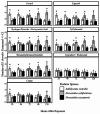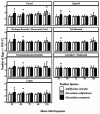Residual effect of commonly used fungicides in strawberries on Amblyseius swirskii, Neoseiulus cucumeris, and Neoseiulus californicus (Mesostigmata: Phytoseiidae)
- PMID: 38869730
- PMCID: PMC11269389
- DOI: 10.1007/s10493-024-00928-1
Residual effect of commonly used fungicides in strawberries on Amblyseius swirskii, Neoseiulus cucumeris, and Neoseiulus californicus (Mesostigmata: Phytoseiidae)
Abstract
Florida's strawberry industry is currently valued at $511 million annually but faces challenges from pathogens and arthropod pests especially Tetranychus urticae Koch (twospotted spider mite) and Scirtothrips dorsalis Hood (chilli thrips). Predatory mites, particularly Neoseiulus cucumeris Oudemans, Neoseiulus californicus McGregor, and Amblyseius swirskii Athias-Henriot, play a crucial role in pest management. However, there are concerns regarding how these biological control agents are affected by fungicides used in current pathogen management strategies. This study assessed the residual effects of commonly used fungicides in strawberries on the survival, feeding, and oviposition of these predatory mites. Commercially sourced predatory mites were reared on S. dorsalis larvae, and gravid female predators placed on fungicide treated strawberry leaf discs in a Munger cell for 120 h. Fungicides tested included two formulations of Captan, hydrogen peroxide + peroxyacetic acid, cyprodinil + fludioxonil, tetramethylthiuram disulfide, cyflufenamid and a control. All fungicides tested had an impact on the survival, feeding, and oviposition of the predators. Among the fungicide treatments, the lowest predator survival was observed in the cyprodinil + fludioxonil treatment, while the highest was observed in the hydrogen peroxide + peroxyacetic acid and tetramethylthiuram disulfide treatments. In all treatments, feeding and oviposition greatly varied among predators; specifically, N. cucumeris and A. swirskii had the lowest prey consumption, while N. californicus had the highest. These findings highlight the potential incompatibility between fungicides and predatory mites and demonstrate the need for the development of a fungicide rotation program tailored to the different susceptibilities of predators to fungicides.
Keywords: Fragaria x ananassa; Scirtothrips dorsalis; Biocontrol; Integrated pest management; Predatory mites; Side effects.
© 2024. This is a U.S. Government work and not under copyright protection in the US; foreign copyright protection may apply.
Conflict of interest statement
The authors declare no competing interests.
Figures



Similar articles
-
Residual effect of commonly used insecticides on key predatory mites released for biocontrol in strawberry.J Econ Entomol. 2024 Dec 28;117(6):2461-2474. doi: 10.1093/jee/toae220. J Econ Entomol. 2024. PMID: 39418124 Free PMC article.
-
Intra-guild vs extra-guild prey: effect on predator fitness and preference of Amblyseius swirskii (Athias-Henriot) and Neoseiulus cucumeris (Oudemans) (Acari: Phytoseiidae).Bull Entomol Res. 2010 Apr;100(2):167-73. doi: 10.1017/S0007485309006944. Epub 2009 May 7. Bull Entomol Res. 2010. PMID: 19419591
-
Life history of the two predacious mites species, Amblyseius swirskii, and Neoseiulus cucumeris (Acari: Phytoseiidae), as biological control agents of the date palm mite, Oligonychus afrasiaticus (Acari: Tetranychidae).Braz J Biol. 2024 Jul 5;84:e283484. doi: 10.1590/1519-6984.283484. eCollection 2024. Braz J Biol. 2024. PMID: 38985072
-
Review: predatory soil mites as biocontrol agents of above- and below-ground plant pests.Exp Appl Acarol. 2022 Jul;87(2-3):143-162. doi: 10.1007/s10493-022-00723-w. Epub 2022 Aug 8. Exp Appl Acarol. 2022. PMID: 35939243 Free PMC article. Review.
-
Factors influencing pesticide-biocontrol agent compatibility: A metadata-based review.Pestic Biochem Physiol. 2024 Dec;206:106204. doi: 10.1016/j.pestbp.2024.106204. Epub 2024 Nov 4. Pestic Biochem Physiol. 2024. PMID: 39672617 Review.
Cited by
-
Residual effect of commonly used insecticides on key predatory mites released for biocontrol in strawberry.J Econ Entomol. 2024 Dec 28;117(6):2461-2474. doi: 10.1093/jee/toae220. J Econ Entomol. 2024. PMID: 39418124 Free PMC article.
-
Banker Plant Efficacy to Boost Natural Predators for Management of Field Populations of Scirtothrips dorsalis Hood (Thysanoptera Thripidae) in Strawberries.Insects. 2024 Oct 8;15(10):776. doi: 10.3390/insects15100776. Insects. 2024. PMID: 39452354 Free PMC article.
References
-
- Akyazi R, Liburd OE (2019) Biological control of the twospotted spider mite (Trombidiformes: Tetranychidae) with the predatory mite neoseiulus californicus (Mesostigmata: Phytoseiidae) in blackberries. Fla Entomol 102:373–381. 10.1653/024.102.021710.1653/024.102.0217 - DOI
-
- Argolo PS, Revynthi AM, Canon MA et al (2020) Potential of predatory mites for biological control of Brevipalpus Yothersi (Acari: Tenuipalpidae). Biol Control 149:104330. 10.1016/j.biocontrol.2020.10433010.1016/j.biocontrol.2020.104330 - DOI
-
- Arthurs S, McKenzie CL, Chen J et al (2009) Evaluation of Neoseiulus Cucumeris and Amblyseius Swirskii (Acari: Phytoseiidae) as biological control agents of Chilli thrips, Scirtothrips dorsalis (Thysanoptera: Thripidae) on pepper. Biol Control 49:91–96. 10.1016/j.biocontrol.2009.01.00210.1016/j.biocontrol.2009.01.002 - DOI
Publication types
MeSH terms
Substances
Grants and funding
LinkOut - more resources
Full Text Sources

